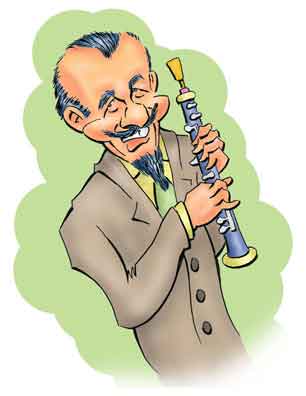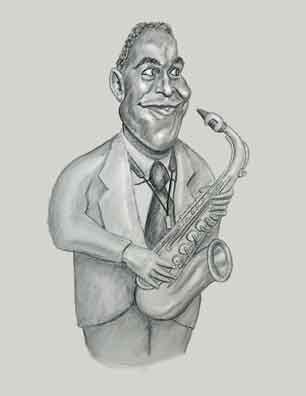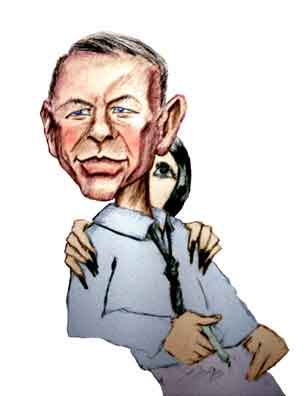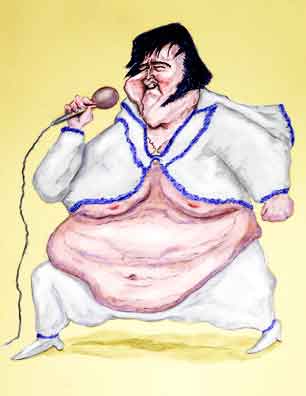Mitch Miller
Singing Along

Mitch Miller
He played with Charlie.
If anyone remembers Mitch Miller it's as the sing-along guy who formed an inverted double "OK" sign with his hands when he directed the chorus on the TV show Sing Along With Mitch. The show ran from 1961 to 1964 - a fair run for the time.
But not many people know Mitch as one of the musicians heard on the iconic jazz album Charlie Parker with Strings. Actually Mitch played only on the first session recorded in 1949, not on the second session the following year. But it's Mitch you hear on the short oboe solo in "Just Friends".

Charlie Parker
Mitch backed him up.
Yep. Long before his famous Sing-Along show, Mitch was well known as a professional oboeist. He garnered considerable respect albeit usually in the classical genre. Composer Virgil Thompson even said, "There is no oboe playing like that of Mr. Miller". And this wasn't a - quote - "compliment" - unquote - like Tom Hulce delivered to F. Murray Abraham in the movie Amadeus ("I never knew that music like that was possible!").
On the contrary, Virgil thought Mitch was "an absolutely first-rate oboist - one of the two or three great ones at that time in the world." Even Igor Stravinsky - not one to give compliments lightly - said that Mitch possessed "the finest musicianship combined with technical perfection." During his career Mitch played in orchestras conducted by the likes of Leopold Stokowski ("Leopold! Leopold!"), Andre Kostelanetz, and he was the oboeist in the 1935 production of Porgy and Bess.
Born on July 4, 1911, Mitch started off studying piano but soon switched to oboe. Like many good oboeists, he showed his talent early, and at age 14 he began taking lessons at the University of Rochester's Eastman School of Music. After he graduated from high school, he entered that prestigious school as a full-time student. He then moved to playing in Broadway orchestras and was the oboeist in the CBS Symphony Orchestra which was CBS's response to NBC's Symphony directed by Arturo Toscanini. He was also one of the musicians heard in the group "Ramon Raquello and his Orchestra", a fictitious band from Orson Welles radio play, the War of the Worlds.

Arturo Toscanini
At NBC
However, being a performing session musician could be an iffy way to make a living, and Mitch moved into producing for Mercury Records and then later for Columbia. All in all he was quite successful promoting shellacs by various artists, not all of whom are remembered today. Among the singers that he helped rise to the top were Tony Bennett, Rosemary Clooney, Doris Day, Frankie Laine, Johnny Mathis, and Patti Page.
Mitch seemed to have had an ear for picking songs that fit the singers. He suggested to Rosemary that she record "Come On-a My House" which was based on an Armenian folk song. Rosemary, then a virtual unknown, thought that the lyrics having such a contrived, even stereotyped accent, made the song sound "just plain silly". But after much argument - during which Mitch threatened to give her the boot - Rosemary gave in. The record became a hit and made Rosemary such a star that she was mentioned in Ian Fleming's James Bond novel Thunderball.
Ironically, Mitch himself didn't care for the popular music that he so avidly promoted. "I wouldn't buy that stuff for myself," he said. And his criteria for selecting a tune was "If I hated it, it would be a hit."
Not that Mitch was perfect. He had Dinah Shore record a song backed by bagpipes and even Mitch admitted the record stunk. Some have argued that Mitch was responsible for the low point in Frank Sinatra's career because of the mediocre songs he had Frank sing. When Frank refused to sing Mitch's picks, Mitch replaced him with the Australian singer Guy Mitchell.

The Young Crooner ...
The truth is Frank's career had been slipping ever since the big band era began dissolving after the Second World War. Frank's singing career didn't revive until he began acting in serious and non-musical movies like From Here to Eternity. The movies brought him back to the public's eye, not as the skinny crooner over whom the bobby soxers swooned, but as the sophisticated and mature Chairman of the Board. From then on Frank could call the shots on what he put on a platter.

... and the Chairman of the Board.
Mitch was willing to compromise. Tony Bennet felt Mitch went too much for the cute novelty songs. Finally they agreed that if they recorded four songs in a session, Tony would pick two and Mitch would select the others.
Well, if Mitch didn't like old style popular tunes, then you know that he was never a fan of rock and roll. However, he recognized its inevitability. Unfortunately, he didn't have such a discriminatory an ear for picking out the rockers. He didn't care for a singer named Buddy Holly, and although he was willing to give a Columbia contract to a young singer named Elvis Presley, Mitch thought the money asked by Elvis's manager, "Colonel" Tom Parker, was too much. So RCA snapped up the swiveled-hipped young singer instead.
On the other hand, if Mitch liked the singing, he didn't care what you called it. He was an early champion of Leslie Uggams who had made a number of early guest appearances on his show. She soon became so popular that Mitch called her up and said he wanted her as a regular. Although Mitch had a reputation for being rather difficult to work with, Leslie said that she and Mitch got along very well. Even well into his old age, Mitch would be sure to see her performances whenever he could.

Buddy Holly
Mitch didn't care for him.
After the show was canceled - rock was just too popular - Mitch continued making guest appearances. Albums of his oboe playing were released, and in 1987 he even conducted a concert with the London Sympthony Orchestra. He died in 2010 at age 99.
But for better or worse, Mitch will always be remembered for Sing Along with Mitch. For those who take time to see some of the shows you'll find a few surprises.
First the Sing Along with Mitch franchise began before the TV show. Mitch had produced a number of albums of old time but popular songs in the late 1950's. The lyrics were printed on the album covers so people could - literally - sing along.
Next during the show, Mitch is on screen very little and mostly just introduces the songs. In many of his shows he didn't spend more than a few minutes in front of the camera.

Elvis
Mitch thought it was too much.
During the songs the camera moves throughout the chorus who are spread out over the stage. These camera pans catch close-ups of selected singers who, we must add, were clearly picked for their singing skills rather than their photogenicity. Many were middle aged, some elderly, a number portly, and almost all were men. Although there were women featured in the show - we mentioned that Leslie was a regular - often they didn't sing at all, and throughout the show's lifetime the songs always maintained their characteristic masculine timbre.
Finally during the closing number and as the camera zoomed in on the singers, the viewers might do a double take. Wasn't that one Johnny Carson (who had just taken over the Tonight Show)? Wasn't that George Burns (still one of the top comics of the world)? Or Joe E. Ross ("Gunther Toody" of Car 54, Where Are You?). The answer for all these questions was "Yes." It was standard practice for Mitch to plant a "hidden" celebrity guest singer in the crowd.
Mitch's basic chorus was a group of two dozen male singers. Among them were several elite soloists. When announcing their songs Mitch would be sure to credit them by name. Standing out was the high tenor who specialized in sentimental ballads. This was a young Robert McGrath - yes the Bob McGrath of later Sesame Street fame. And we have to admit it. Bob really could sing.
And finally, in those more delicate times it was inevitable that there was some censorship - even when they didn't need it. Once the gang performed a Gilbert and Sullivan song where they were worried that a particular word might cause offense.
No, this was not from the infamous "banjo serenader" line of "I've Got a Little List". It was in "A Policeman's Lot" where instead of the sergeant's original lyrics:
"When the coster's finished jumping on his mother,
He loves to lie a-basking in the sun."
... the line used was:
"When the coster's finished SPONGING [emphasis added] on his mother,
He loves to lie a-basking in the sun."
The reference, though, really merited no bowdlerization. In Victorian England it was a common stereotype that a "coster" or "costermonger" - a pushcart vendor of fruits and vegetables - was notoriously ill-tempered. So "jumping on" is likely a reference to verbal berating than anything else. That some think it might have another meaning is more of a comment on our culture rather than that of Gilbert, Sullivan, or Victoria. So we just have to Get Along with Mitch.
References
The B Side: The Death of Tin Pan Alley and the Rebirth of the Great American Song, Ben Yagoda, Penguin, 2015.
"Mitch Miller", David Hinckley, New York Daily News, November 28, 1999.
"Sing Along with Mitch", Internet Movie Data Base, 1961-1964
"Mitch Miller", Michael Freedland, The Guardian, August 3, 2010.
"Leslie Uggams - Interview", American Archive of Television, Emmy Legends.
"Mitch Miller, Maestro of the Singalong, Dies at 99", Richard Severo, The New York Times, August 2, 2010.
"A Chronic Case of Old Corn", Life Magazine, October 13, 1961.